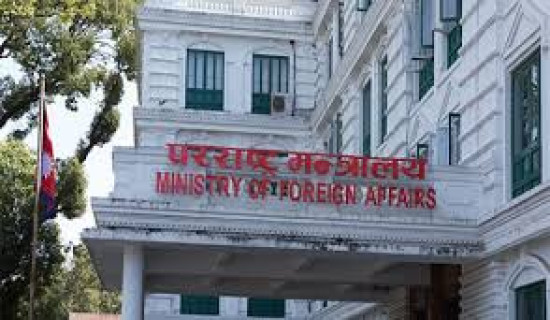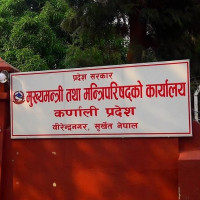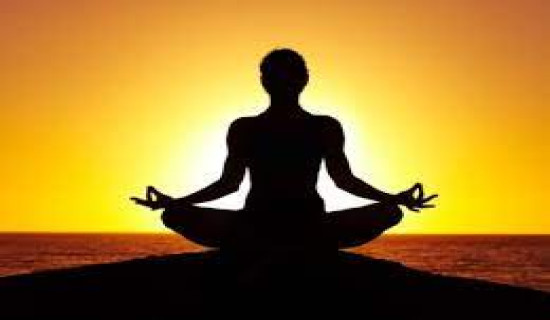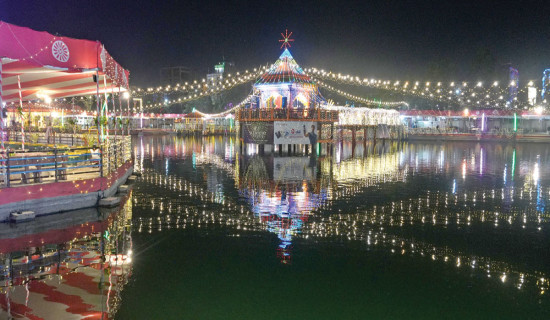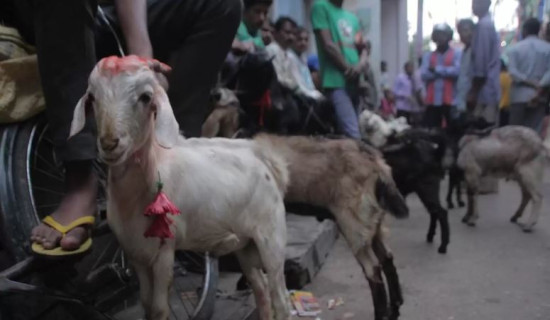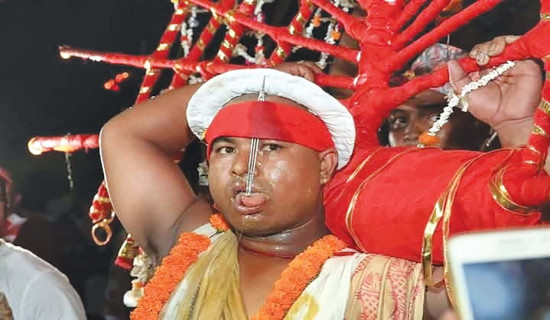- Thursday, 8 January 2026
Mahakali and Bhairav dances of Nagadesh concluding today
Kathmandu, Aug. 24: The Prajapati community of Nagadesh Tole, which revived the historically and religiously significant Mahakali dance after a gap of 80 years in 2022, has started performing this year’s dance. Similarly, the performance of the Thimi Bhairav (Bhaila) dance has begun at Tahanani Tole of Ward No. 5 of Madhyapur Thimi, where the dance is being shown after a gap of 21 years.
Both Mahakali and Bhairav dances began on Wednesday and will conclude on Saturday.
This year, the Prajapati community has managed to stage the Thimi Bhairav dance while Prajapati Shrestha community is now staging the Mahakali dance, said Samir Sankhadev, dance teacher of Mahakali dance. The Mahakali dance began from Nagdesh Tole of Madhyapur Thimi Municipality-5 on Wednesday.
The Devgans go around through their designated routes, reaching various junctions and platforms (Dabalis) of the city and dance.
Five Devgans are associated with the Bhairav dance. Each of them performs the dances of five various deities. Of them, two perform as Bhairav, two as Kumari and one as Harisiddhi.
Among the two Bhairavs, the first is Prachanda Bhairav which is being performed by Ashok Prajapati, and the second is Batuka Bhairav being performed by Balmukunda Prajapati. Likewise, Aayush Prajapati and Shahil Prajapati are performing as Kumari, and Harisiddhi dance is performed by Trishal Prajapati.
Initially, the Thimi Bhairav dance used to be performed by a single leader and group of the Prajapati community. However, since 1988, two groups and two leaders have started performing this dance.
One dance group is led by Shree Gopal Prajapati and the other by Dinanath Prajapati, said Sankhadev.
This year, the dance group is led by Shree Gopal Prajapati. It is not known when and where the other group led by Dinanath will perform the dance. The dance steps of the two groups differ from each other.
Shree Gopal Prajapati and Krishna Bahadur Prajapati have taught dancers of Bhairav to revive the masked dance, Sankhadev said.
Elaborating on the rules the dancers need to follow, Sankhadev said that the dancers should not be touched by dogs, their legs should not be touched by other people, the mother and father of the dancers should not observe the performance, and the dancers’ family members should not watch it from their windows and balconies of their homes.
Similarly, there are 26 people associated with the Mahakali dance. Of them, 17 are Devgans who dance as various deities- Mahakali, Mahalaxmi, Kumari, Vetals, Bhairav, Kawang, Khyak, Simgha, Maka and others, said Birendra Bhakata Shrestha, a local.
The remaining members play music and carry out other activities to successfully portray the battle between the goddess and the demon Mahisasur through the colourful masked dance. They also go around the designated route.
Believed to have been started by King Subarna Malla in the 16th century, the folk dance was last performed in the 1940s.
Last year, the Mahakali masked dance was limited to a single day due to the route around the junctions and platforms (Dabalis) of the Bhairav and Mahakali dances overlapped. The route of the two dances should be different. When the dances passed through the same route, the Mahakali dance concluded in a single day. This year, separate routes were managed for the dances by holding a meeting, said Sankhadev.



